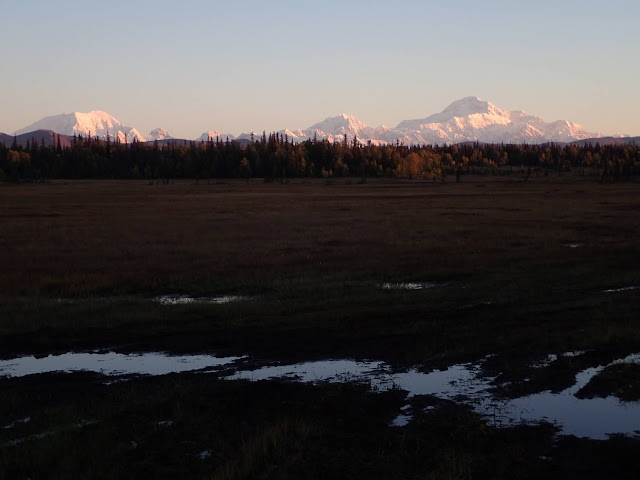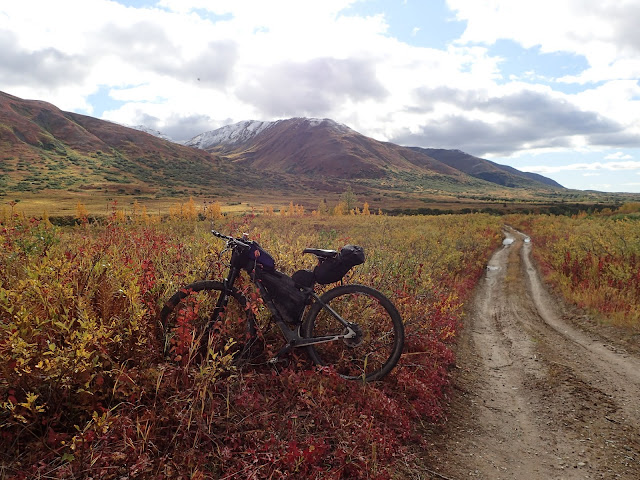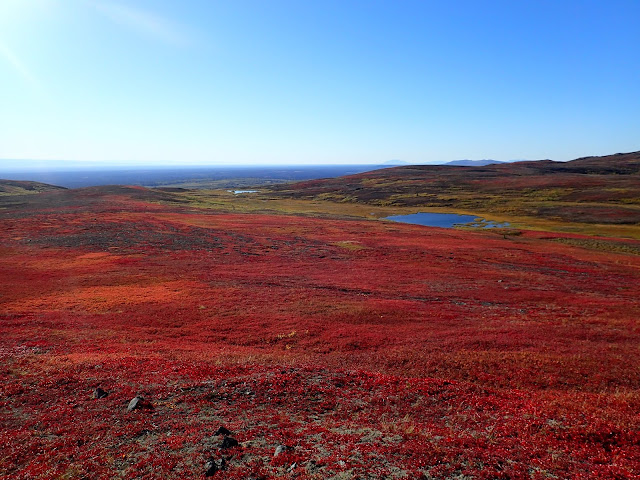Oh. My. Gosh. Can you believe this? Absolutely amazing!
These and other superlatives kept coming this weekend as we biked and hiked along the Petersville Road.
Neither Eric nor I in all of our years in Alaska had ever been down this road, though we had considered it many times. Well, it’s definitely not to be missed, especially if you have a few days like we did. Sunny skies, minimal winds, no bugs, and fall colors at their prime. It was jaw-dropping spectacular. (Another superlative!)
I had a few days off from work as I was supposed to be racing the Dirty Kanza Extra Large, a gravel bike race that was rescheduled from May and rescheduled again until next year due to Covid. The weather forecast for Fairbanks was grim with rain likely most days. But it looked like it might be nice south of the range. I was having a hard time motivating due to the weather, but then I remembered that Lael Wilcox had just ridden the Petersville Road. It looked interesting and was somewhere new to explore. After an internet search I found the Gate Creek Cabins, which are just at the end of the paved part of the road, 10 miles in. The cabins are fully furnished, with electricity and running water. I called and they had availability. I must be getting soft in my old age, but it was just the nudge I needed to motivate to get out of town. Whatever it takes. As always, Eric was right on board and ready to see some new country. (The cabins were wonderfully run. A great place to stay!)
It rained the whole way down from Fairbanks, so we were really happy we had a dry, warm cabin waiting. By the time we went to bed, the skies had started clearing.
PETERSVILLE ROAD BY BIKE
The next morning was cool and sunny. We were ready for some adventuring! I wanted to bike to the Cache Creek crossing (about 35 miles from the Parks highway) but also wanted to explore some of the side ATV trails if possible. Eric wasn’t sure how much biking he wanted to do, so we drove to just past the Forks Roadhouse (now closed), at about 20 miles in, and started from there. On the drive, the views started immediately with Denali and the surrounding peaks all out in their glory. Several open areas across swampy meadows offered outstanding views. We also noted that almost every pullout had at least one truck, ATV or RV. Some had several. Hunting season was definitely on. Even so, the traffic was minimal. We guessed that most hunters were out on the many trails that took off from the road.
 |
| Dawn sunlight on Denali and surrounding mountains |
 |
| RV's and trucks at every pullout |
The road was a lot of fun to bike. Fairly short uphills with nice grades. Fun, swoopy downhills going in and out of drainages. Mostly good gravel with lots of potholes, though easily avoided on bike. The scenery kept changing between woods and meadows, with the big mountains and nearby hills providing a backdrop. It was such a glorious day that we kept stopping to take photos. The fall colors were absolutely stunning. Our cameras just couldn’t capture the glowing yellows and reds, but we kept trying.
Just before the “community” of Petersville, we followed a side road for a bit until it ended at what appeared to be a private mine with a family and their RVs. Back on the main road we passed through Petersville, a collection of about four or five buildings, obviously lived in and well taken care of. We followed the road through a very scenic canyon and then bombed down the other side, crossing Peters Creek on a bridge. As the day wore on, the big mountains became shrouded in clouds, but the fall colors and hillsides were still amazing. We kept stopping to take photos and look around.
 |
| Getting close to the metropolis of Petersville |
 |
| Looking down on Petersville |
 |
| North side of the canyon |
After the bridge we saw a side road to the right going way back up into the Dutch Hills just north of the Peters Hills. (These “hills” would be mountains in other places, but when you’re right next to Denali you become a hill.) We could see some buildings and vehicles way up there. It looked intriguing so we followed it. We had to ride through some puddles but then came to another crossing of Peters Creek, this time without a bridge. We easily crossed the first braid, but the main channel was over knee deep. We weren’t sure we wanted to get that wet. The air temperature was only around 45F. Plus, a few minutes before, a guy on an ATV warned Eric that he had seen a wounded black bear a couple of miles up the road. That all was enough to get us to give up on that route, especially since we still hadn’t been to the end of the main road. We wistfully looked at the continuing side road then let common sense prevail and turned back.
 |
| Eric crosses the easy braid of Peters Creek |
 |
| Contemplating whether to go on or turn around |
We biked up a steep narrow side road and were surprised to find a large RV at the top. Miners get those things in some incredible places. We started on a side trail from that road, but after having to cross some tricky puddles, we stopped for lunch. We decided that side trail was more “exploring for another day.”
 |
| Not a bad lunch spot |
 |
| Heading back down to the main road |
The bike back on the main road was just as much fun as on the way in. We had to climb to get through the canyon, but then it was rolling hills, mostly trending downhill. When we got back to the car, I decided to bike the last 10 miles back to our cabin while Eric drove the car.
PETERS HILLS HIKE
The next morning, we got up early to hike into Peters Hills. We wanted to be up high to see the mountains before the afternoon clouds covered them up. (Little did we know that the mountains would be out all day!) We drove back to about a mile past Petersville and started hiking on a steep ATV trail. (Read about this hike in “55 Ways to the Wilderness in Southcentral Alaska.”)
 |
| The first part of the trail was rutted and muddy |
The morning was cool and crisp, right around freezing, but we warmed up as we headed uphill. We followed some bear tracks on an often-muddy ATV trail and after a couple of miles broke out into tundra.
 |
| Bear tracks! |
 |
| Tundra hiking |
At about mile 3 we hit a high point (2840’) and the view opened up. OMG! It was absolutely jaw-dropping, amazingly spectacular. Denali, Mt. Hunter, Mt. Foraker, and all the surrounding peaks were in view with the morning sunlight on them. The sky was crystal clear blue. Small lakes dotted the nearby tundra, aglow in reds. We just couldn’t believe our luck. We must have picked the best day of the year to be up there.
We continued hiking off-trail across a valley and then up a steep climb to a higher overlook (3600’). The views just kept getting better. Here, about 7 miles in, signs told us we had crossed into Denali State Park. But we weren’t done. An even higher point, farther east, beckoned.
We headed down and passed what has to be one of the world’s most glorious camping spot – a flat soft surface on a mountain lake with a full view of Denali. We mourned leaving our tent and sleeping bags behind!
 |
| Primo backcountry camp site. Too bad we didn't have our overnight gear. |
We continued up until we finally topped out at Longs Point (3929’), 9 miles from the trailhead. Sydney Laurence painted many canvases of Denali near here. No mystery as to why. The entire range of mountains rises up before you. Glaciers spill off the mountains. River valleys spread out where the glaciers end. Incredible! We stopped for lunch and more photo opportunities before heading back.
 |
| Amazing lunch spot! |
For the most part hiking in Peters Hills was great. Nice tundra walking, brushy in places but mostly easy to avoid. A couple of stream crossings that were easily navigated. Tons of blueberries, although they were past their prime. The fall colors were amazing. (Have I said that already?)
 |
| Foraging for overripe blueberries |
We passed many wonderful little lakes that would make great campsites. We really wished we had brought our overnight gear. In our opinion, the Peters Hills views are even more spectacular than at Wonder Lake or on Kesugi Ridge.
And there were NO people. On our way back, we saw only one person off in the distance with her dogs. We saw her tent at the first lake with nice views of the mountains, a fairly easy 3-mile hike in. That was the only person we saw all day. Granted it was a Friday, but still. (The next day, on the drive north we saw that two of the Kesugi Ridge parking lots were crammed full.) Easy access to incredible views and we had it all to ourselves. Where else can you say that?
Even though it took us more than 30 years, to explore Petersville Road, it was worth the wait. But don’t wait that long before you visit this incredibly scenic and less traveled area.
(We really mean don't wait. If the South Denali Visitor area ever happens, it will really change this area. It would be a nice asset, but you wouldn't have it to yourself anymore.)
Packrafters: Here's a trip you can do that includes Peters Hills.
 |
| Petersville Road bike |
 |
| Peters Hills hike to Longs Point |































